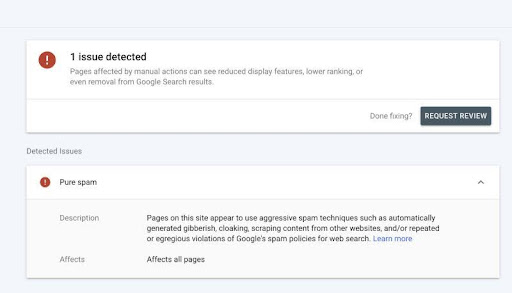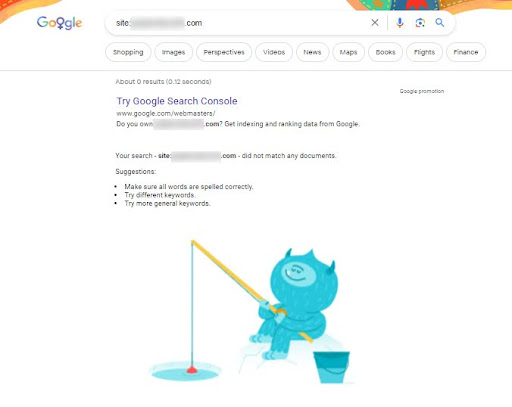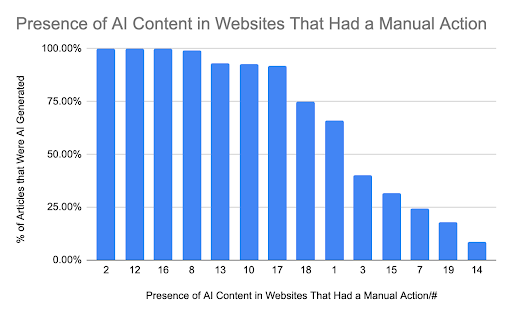Google Launches a “More Complex” Core Update and New Spam Policies. Should Brands Be Worried?
Table of Contents:
- What Happened?
- What Does the Update Mean for You?
- What is Helpful Content?
- Understanding the Spam Update
- Who Is Being Impacted?
- Can You Use AI to Produce Content?
What Happened?
On Tuesday, March 5, 2024, Google announced their March 2024 core update along with new spam policies in a post entitled, “New ways we’re tackling spammy, low-quality content on Search.”
They followed up with a deeper explanation on the Google Search Central Blog entitled, “What web creators should know about our March 2024 core update and new spam policies” which delved even deeper into the particulars of the update.
According to Google, the focus of this update will be:
- Improved quality ranking. “We’re making algorithmic enhancements to our core ranking systems to ensure we surface the most helpful information on the web and reduce unoriginal content in search results.”
- New and improved spam policies. “We’re updating our spam policies to keep the lowest-quality content out of Search, like expired websites repurposed as spam repositories by new owners and obituary spam.”
Since 2022, Google has been rolling out periodic updates to their Core Ranking algorithm designed to reward what they call “helpful content.”
However, Google has stated:
“The March 2024 core update is a more complex update than our usual core updates, involving changes to multiple core systems. It also marks an evolution in how we identify the helpfulness of content.
Just as we use multiple systems to identify reliable information, we have enhanced our core ranking systems to show more helpful results using a variety of innovative signals and approaches. There's no longer one signal or system used to do this, and we've also added a new FAQ page to help explain this change.”
Unfortunately, the effectiveness of these core updates in terms of showing more high-quality websites and content in their search results have often received mixed reviews. There are even studies indicating that results have become appreciably worse over recent years. In fact, Google’s own executives have admitted as much recently.
According to Google’s estimates, they expect “the combination of this update and our previous efforts will collectively reduce low-quality, unoriginal content in search results by 40%.”
We don’t usually comment on the effects of Core Updates, and Google themselves have gotten into the habit of confirming them less and less frequently. However, the fact that Google has gotten out ahead of this one likely means that for sites using questionable tactics, the end of the SEO gravy train may be near.
There have been reports that in the early stages of this update, which may take up to a month to fully roll out, some sites alleged to have been using AI-heavy content have been completely de-indexed after receiving manual penalties.

In fact, according to the AI Checker and Plagiarism platform Originality.ai, of the 79k websites they quickly reviewed, over 1.4k (2%) had a Google “manual action” penalty like the one above applied to them and are thus completely deindexed.

To take things a step further, Originality.ai deep-dived into the content of a subset of the websites that received a “manual action” penalty from Google. They found that 100% of the websites had some posts that were AI-generated, while 50% of the sites had 90%-100% of their posts generated by AI.

What Does This Mean for You?
Let’s begin with the “Improved quality ranking” aspect of this update. In order to understand what Google means by “helpful content,” we must dig into what they have publicly communicated in terms of guidelines, and then determine how the guidelines apply to your unique situation and SEO strategy.
What Is “Helpful Content” According to Google?
This topic is simultaneously simple and incredibly complex.
At its most basic root, “helpful content” is content that meets the needs of the searcher for their given query. This seems quite basic, right?
What makes the topic complex is an unavoidable contradiction in terms of what Google says they want, and what content creators must do to succeed. Here are a few key issues that content creators and Google face:
- As content creators, we inherently want people to visit our respective websites, buy our products or services, and so on.
- Anticipating the needs of people who might be searching for and finding your website is not always easy, so we must rely on tools and intuition to tell us what people are searching for (and how often).
- Like a horse chasing a carrot, content creators create content designed to rank well for the queries we want to rank for, in order to pull in traffic.
Google says directly in their guidelines not to create content “to gain search engine rankings.”
But is that a realistic perspective coming from a company that exists to catalog the world’s information and makes a living from those of users, filling it with content that they can rank and make money from?
We don’t think it is. It’s only natural that websites would want to rank well on Google so that they can reap the benefits. To expect otherwise is not realistic or rational on Google’s part.
However, getting back to the question of what “helpful content” is, here are a few important points from their guidelines (almost all of which we agree with):
#1. “Helpful content” is high quality. This is somewhat subjective and the needs vary depending on the search query and user, but generally speaking, high-quality content exhibits the following characteristics (taken directly from Google’s self-assessment questions):
- The content answers a question or search directly and as succinctly as necessary.
- If more or less depth is required for a given topic, the content is as in-depth as needed without adding words for the sake of meeting certain word counts.
- The content contains accurate and timely information, reporting, research, and analysis in an original way.
- The content is insightful or interesting in a way that may be pleasing to users.
- The content draws from other sources and doesn’t simply copy and regurgitate those sources, instead adding valuable and original supplementary commentary.
#2. “Helpful content” builds trust by showcasing expertise and authority. The content presents information in such as way that it builds trust with the intended audience including evidence of:
- Subject matter expertise on a given topic with very few (if any) factual errors
- High-quality sourcing of information when necessary
- Topical authority from the brand or content creator, evidenced via background information supporting why the brand or content creator should be trusted
- Recommendations or reviews from other respected creators and publishers through testimonials, social media sharing, or inbound linking
If you still have questions, we recommend familiarizing yourself with the concept of E-E-A-T (experience, expertise, authoritativeness, and trustworthiness). While E-E-A-T is not a specific ranking factor, it is an overall theme for the types of websites and content that Google is working their best to reward in organic search rankings.
#3: “Helpful content” is (typically) served on a reputable site that provides a “great page experience.” You can read about page experience in terms of how Google measures it algorithmically, but here are some quick pointers:
- The website is reputable
- The website is secure
- The website is fast and reliable
- The content is easy to consume on all devices
#4: “Helpful content” focuses on people, but still checks the right boxes with SEO. Again, it’s not realistic to just create content for people, but it is realistic to create content that is both good for your users and at the same time incorporates many SEO best practices:
- The content balances the needs of your audience and gives them what you know they want, need, and are searching for.
- The content is generally indexable and well-structured, with good URL structure, page titles, metadata, internal links, etc.
What You Need to Know About the Spam Update
As mentioned above, the second part of Google’s March 2024 core update is the introduction of new (additional) spam policies. We believe that this is the most poignant and perhaps most impactful aspect of the update, given the many manual Google penalties already being handed out.
Here are some of Google’s comments regarding their new spam policies:
“Our spam policies are designed to address practices that can negatively impact the quality of Google's search results. Today, we're announcing three new spam policies against bad practices we've seen grow in popularity: expired domain abuse, scaled content abuse, and site reputation abuse.
We encourage content creators to review all of our spam policies and ensure they aren't engaging in such practices. Sites that violate our spam policies may rank lower in results or not appear in results at all. If affected by a spam manual action, site owners will receive a notice through their registered Search Console account and can apply to have the action reconsidered.”
Additionally, here are snippets Google has provided about each new policy:
“Expired domain abuse is where an expired domain name is purchased and repurposed primarily to manipulate Search rankings by hosting content that provides little to no value to users.”
“Scaled content abuse is when many pages are generated for the primary purpose of manipulating Search rankings and not helping users. This abusive practice is typically focused on creating large amounts of unoriginal content that provides little to no value to users, no matter how it's created.”
They specifically expound upon the scaled content abuse section to provide guidance on AI-generated content:
“Our long-standing spam policy has been that use of automation, including generative AI, is spam if the primary purpose is manipulating ranking in Search results. The updated policy is in the same spirit of our previous policy and based on the same principle. It's been expanded to account for more sophisticated scaled content creation methods where it isn't always clear whether low quality content was created purely through automation.”
Google ends the guidance speaking to site reputation abuse:
“Site reputation abuse is when third-party pages are published with little or no first-party oversight or involvement, where the purpose is to manipulate Search rankings by taking advantage of the first-party site's ranking signals. Such third-party pages include sponsored, advertising, partner, or other third-party pages that are typically independent of a host site's main purpose or produced without close oversight or involvement of the host site, and provide little to no value to users.”
We recommend reading more about these spam updates (especially the AI part), as well as Google’s overall guidelines on what constitutes spam.
Who Should Be Worried?
As with any update, some sites should worry (and for good reason). Some may end up as collateral damage, while others may end up unscathed (and might actually win) as a result. Here are the trends we are seeing in heavily impacted sites.
Sites spinning poor-quality, automated, and/or AI-generated content at scale.
These spam sites have been making their way into Google’s rankings for some time now. Their efforts have only been accelerated via the recent advances in AI which make it easier to increase the velocity of content production and automation.
The update is largely focused on putting these types of websites and “churn and burn” practices out of business in favor of websites that are building valuable content in a responsible way.
The line of demarcation here is, “How much AI is too much?”
It would be unrealistic to expect that nobody uses AI to enhance or speed up their content processes, but where do you draw the line and when does it become risky?
That is the question that Google and content creators are trying to wrestle with. While there isn’t a magic number that is going to cause a site to get penalized and deindexed, if you’re using AI (or any other means) to produce lower-quality content at scale just to rank in Google, you’re likely putting yourself at risk.
Sites publishing third-party content without oversight.
If you are operating a site predicated on third-party content, and there is no mending of the fence concerning content, then it might be time to reevaluate your strategy.
Be wary of user-generated spam content on your site (e.g. on a subdomain or subdirectory), the sponsored content you put on your site, and what content you import into your website.
We’ve observed examples of brands that may acquire a website and want to merge the content. If that’s you, do your diligence and know what you’re merging into your website.
Brands who buy expired domains and use them solely for SEO.
The practice of buying expired domains, if done for legitimate purposes, isn’t inherently bad for SEO. If you’re using an old domain in the right way and for the right reasons, it’s fine.
However, if you’re using expired domains to transfer the search authority of any old links going to that domain to your website, and/or housing low-quality content on that website to garner a few SEO rankings, you’ll eventually pay the price.
We recommend that you stop before the damage extends to any other domains you might own.
Can you use AI to produce content?
This is a major point of contention, and one Google has talked out of both sides of their proverbial mouth about.
In 2022 they said that AI Generated Content was against their guidelines, but in 2023 Google clarified that it’s fine as long as the content is useful and written for people.
The reality is that the world is moving towards widespread AI adoption, and it has valuable use cases even within SEO when it comes to improving efficiency and scalability. That being said, considering how much or how little AI to use in your strategy can be tricky.
Our general recommendation is that your content, as much as possible, should be written by humans for humans. That helps to mitigate risk, though it isn’t always a guarantee that your content will always rank well alone.
If you can generate high-quality content using AI, then by all means do it, but we HIGHLY recommend against blindly publishing it. Any content produced using AI should have heavy human oversight, review, and editing ahead of publishing.
Additionally, it’s important to keep in mind this quote from Google’s John Mueller:
“By definition (I'm simplifying), if you're using AI to write your content, it's going to be rehashed from other sites.”
He’s 100% right as this is how AI models get trained.
In addition to heavy human oversight of any AI-generated content, we also recommend that you do your best to incorporate many of the fundamentals of what Google deems “helpful content” such as:
- Unique opinions that are particular to you and/or your brand, and showcase your subject matter expertise as a content creator
- Unique data and proprietary research or other never-before-seen information (or information that has been barely seen)
Additionally, we highly recommend against using unfiltered AI content at scale. Just don’t do it.
While it may take a little longer and be more tedious or constraining from a resource standpoint, the risks of losing your organic traffic and revenue (especially as a large brand) likely outweigh the benefits of using AI to quickly spin up content.
While we certainly like the idea of being able to move faster, there has to be a high threshold of quality in the content that you’re putting out there. If the use of AI compromises that to a significant degree, then what is it really doing for your brand?
How Should Brands and Content Creators React?
Generally speaking, when managing your SEO strategy, we recommend:
1) Play the long game: Treat your organic search presence like you would a 401k. Consistent deposits focused on long-term, sustainable growth.
2) Pick your spots wisely: It’s okay to be aggressive, but we recommend making ethical, smart SEO investments that are focused and calculated, making strategic bets where it makes sense for your brand.
3) Manage your risk: Be smart and (especially if you’re a large brand with a lot to lose) be risk-averse with your content creation and SEO strategies. Don’t fall into the trap of taking risky shortcuts, especially when your brand depends on organic as a major source of revenue. It’s just not worth it.
The great news is the advice above would have been our advice both before and after the update, so if you were practicing that, then likely your approach and outlook don’t need to change.
If you have any questions about how this Google update might affect your brand, or you’re considering how to incorporate AI into your SEO or content marketing efforts, please reach out to us for advice! We’re more than happy to help take it further (pun intended).





